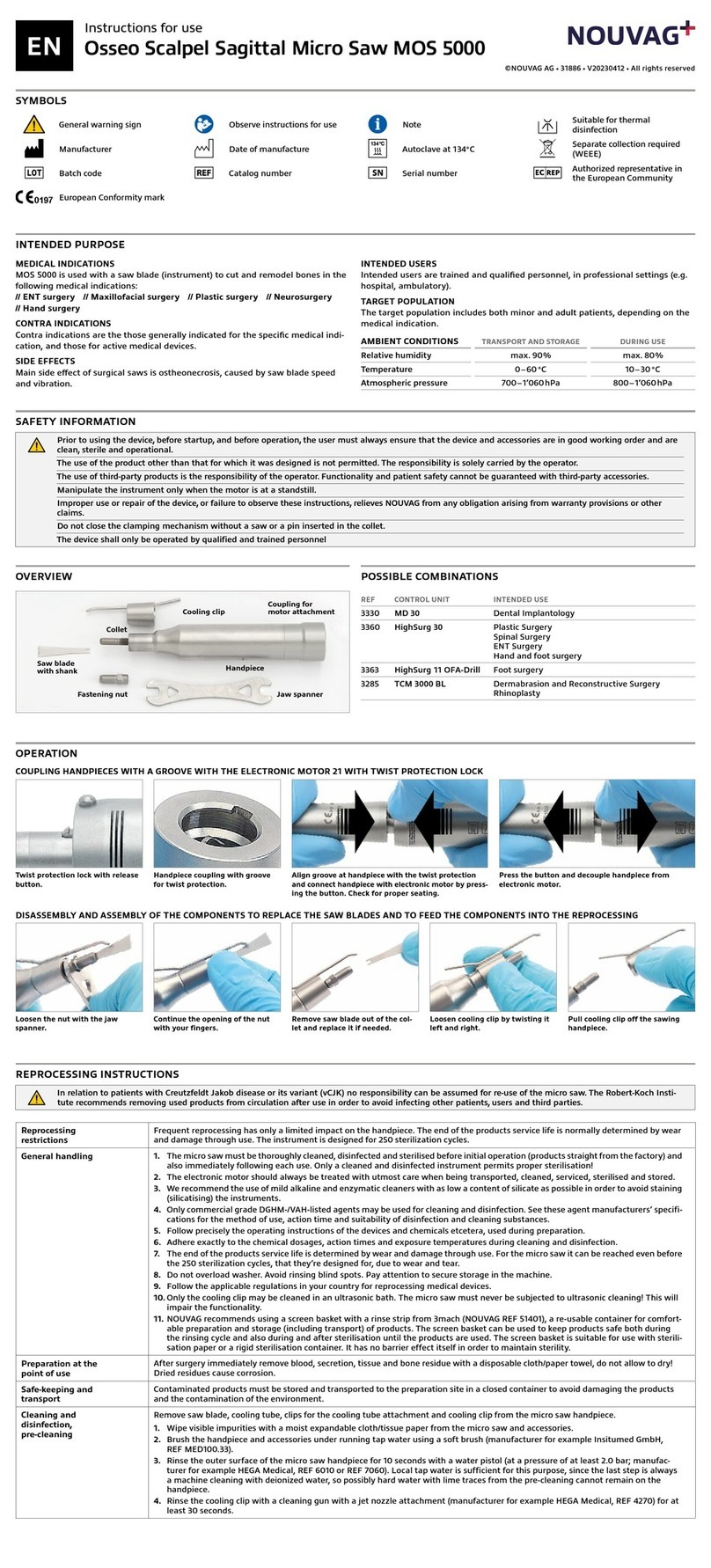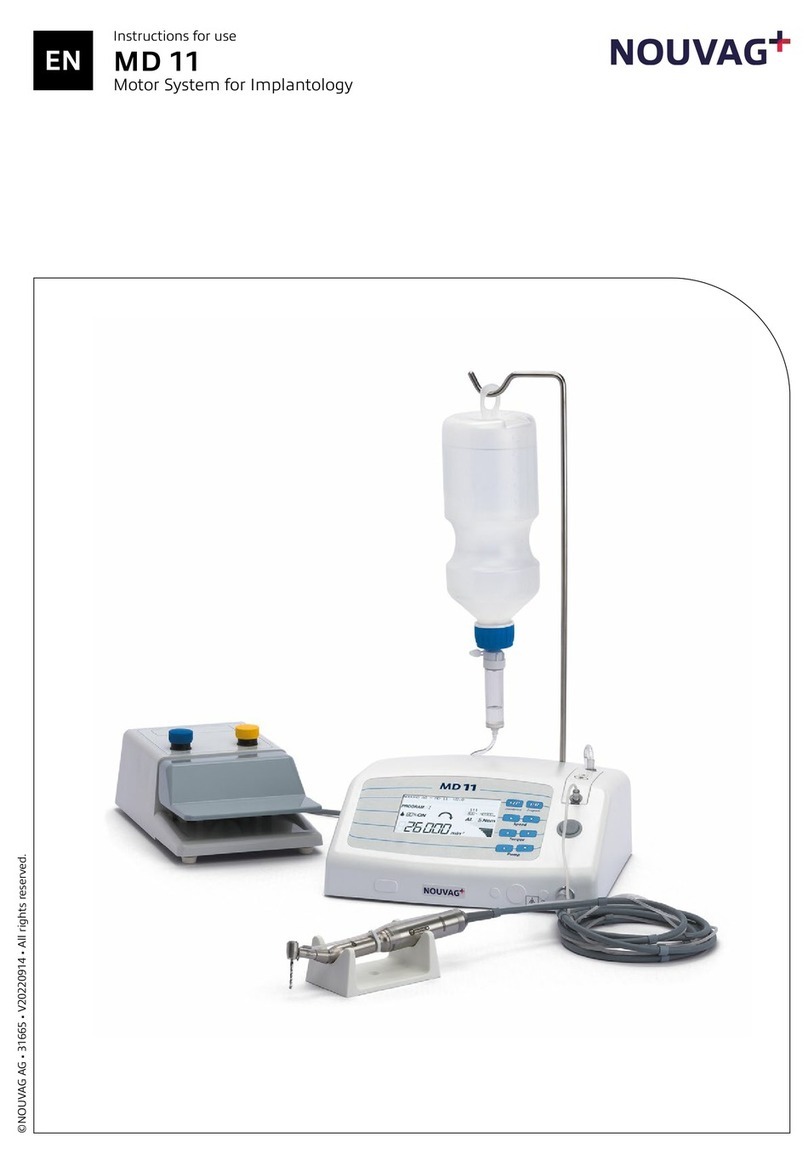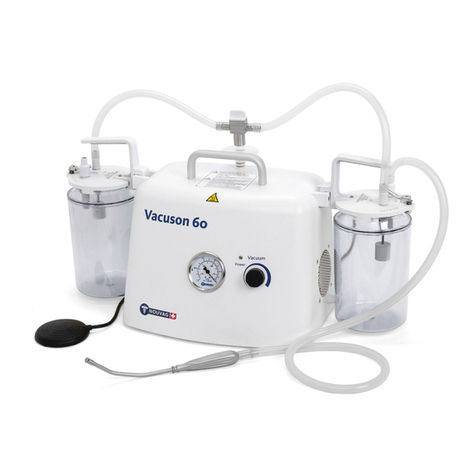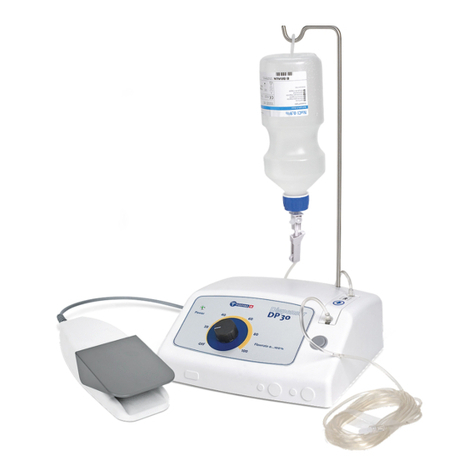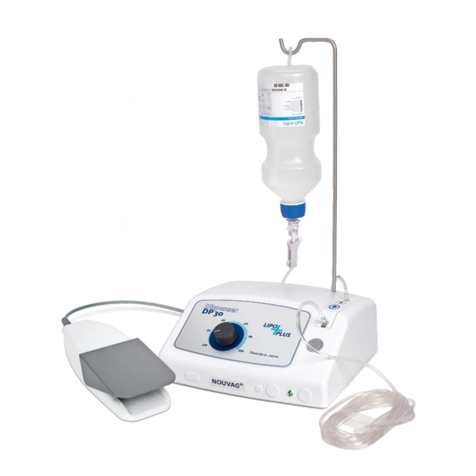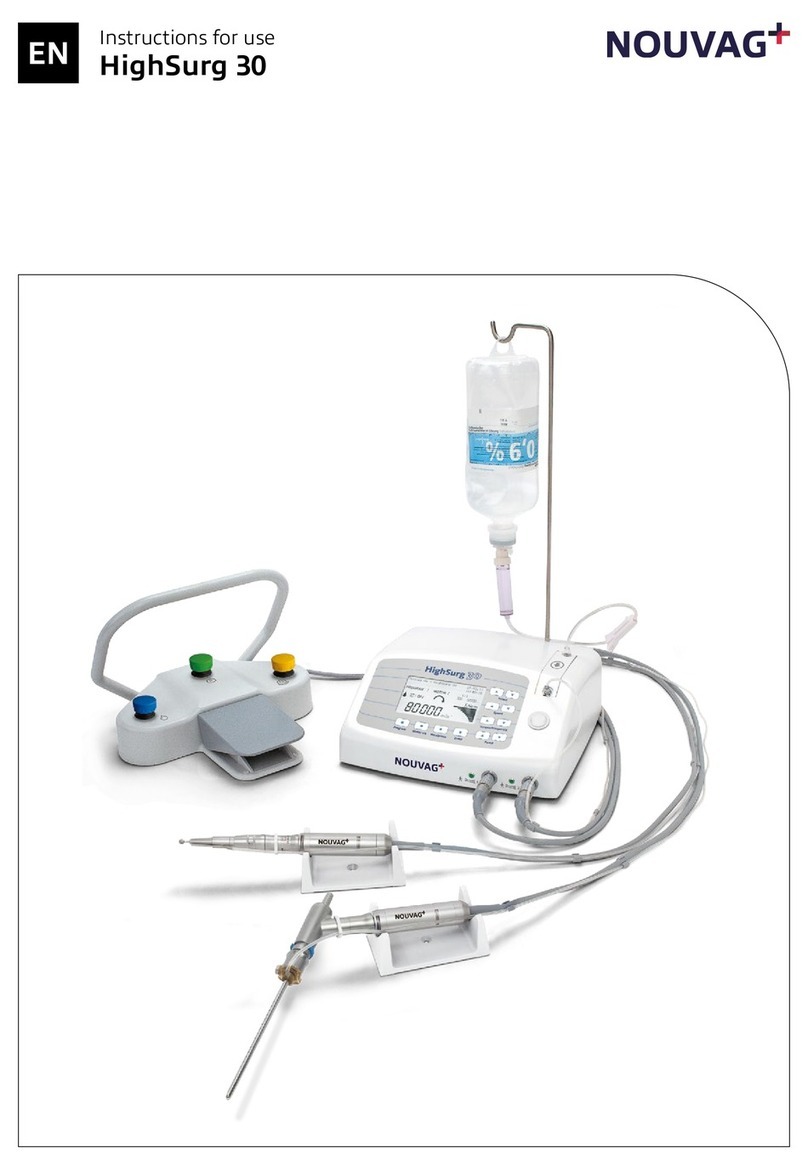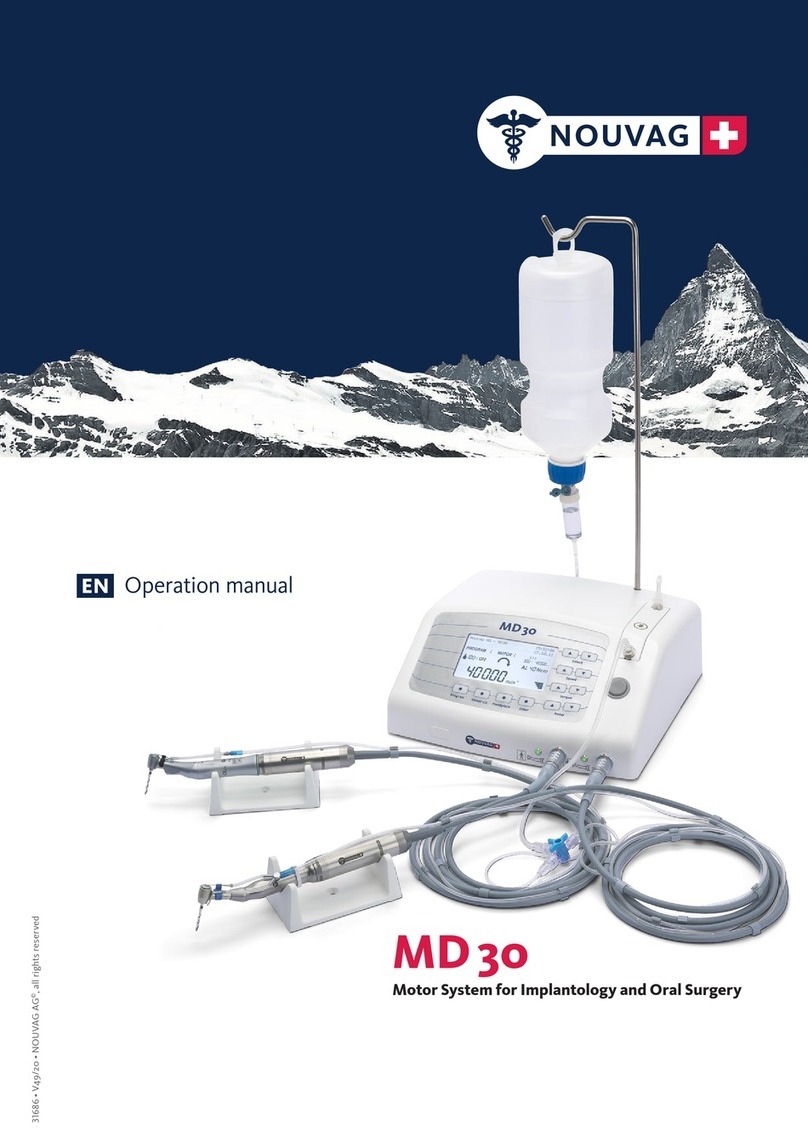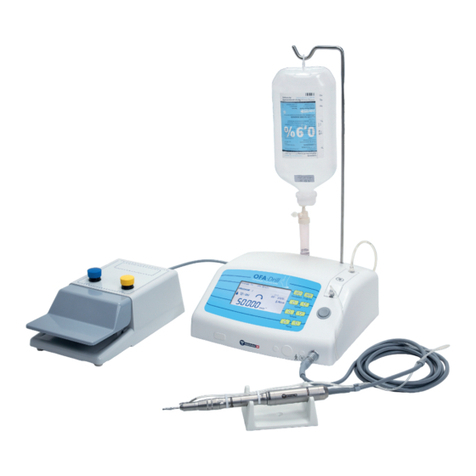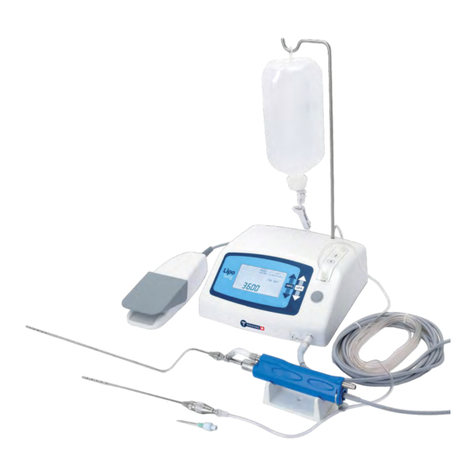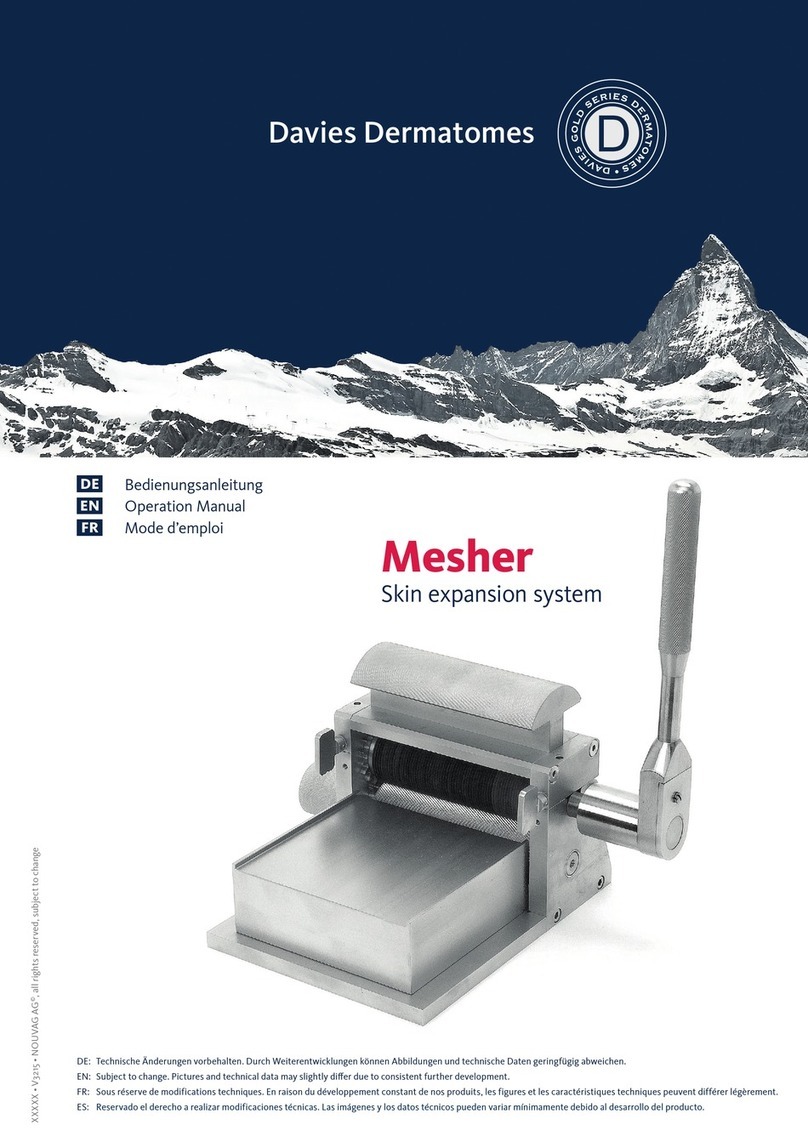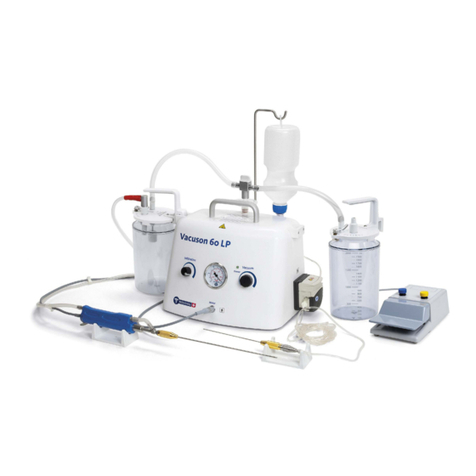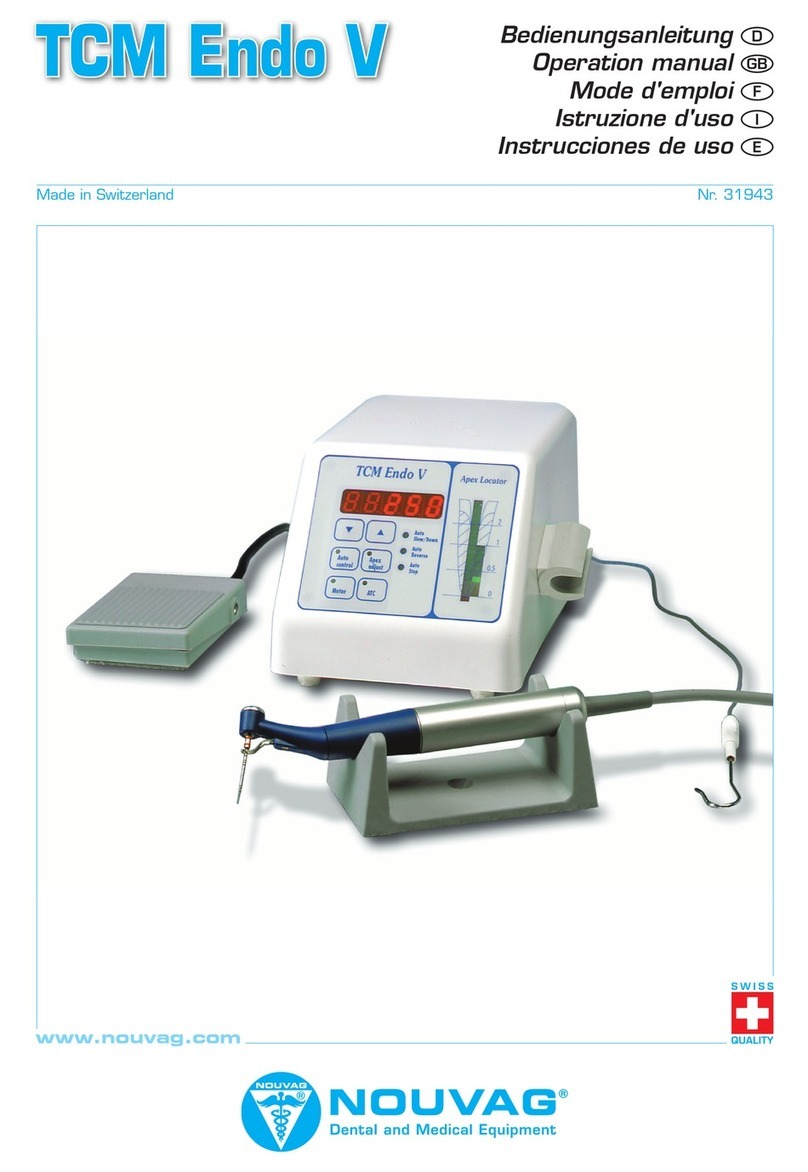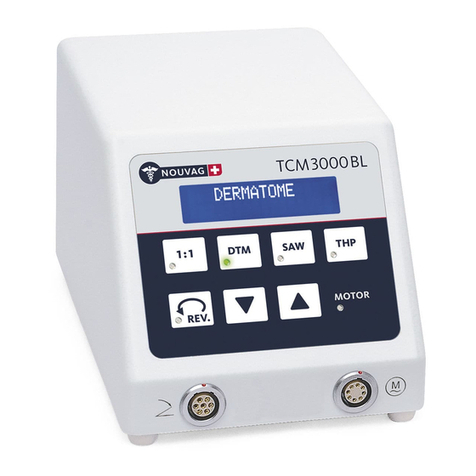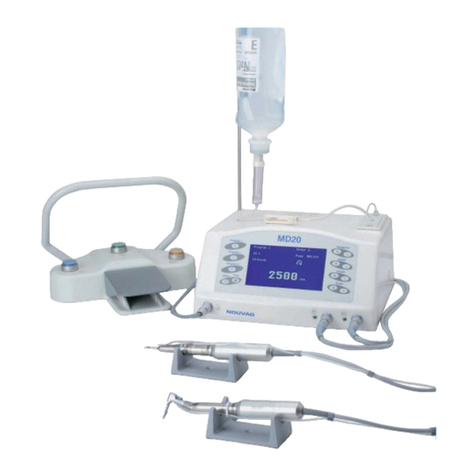
REF
Cleaning Mechanical cleaning
1. After pre-cleaning place the micro saw and its accessories in the strainer basket.
2. Mechanical cleaning is only successful if the pre-cleaning, described above, is ad-
hered to!
3. Cleaning is done using the Vario TD programme in the cleaning and disinfection
unit (CDU). For the cleaning process it is advisable to use DI water (fully desalinated
water).
4. After completing the cleaning programme (inc. Thermal disinfection) check the mi-
cro saw, the nut and the cooling clip for visible contamination in grooves and gaps.
Repeat the cleaning cycle, if necessary.
Automatic cleaning process (Vario TD programme)
1. Pre-clean with cold water for 4 minutes.
2. Empty
3. Clean for 5 minutes at 55°C with 0.5 % alkaline or
at 40°C with 0.5 % enzymatic cleaner.
4. Empty
5. Neutralise with cold water for 3 minutes.
6. Empty
7. Inter-rinse for 2 minutes with cold water.
8. Empty
Disinfection Mechanical disinfection
The cleaning/disinfection unit has a thermal disinfection programme which follows
after the cleaning. When performing mechanical thermal disinfection, give due consid-
eration to the national requirements relating to the A0 value (see DIN EN ISO 15883-1).
We recommend an A0 value of 3,000 for the instrument. Disinfection must be carried
out with DI water.
Warning
When inadequately rinsed or exposed to the disin-
fectant or detergent for too long, the instrument can
corrode. Please see the corresponding detergent and
disinfectant’s package insert for dwell times.
Drying Mechanical drying
Dry the micro saw using the cleaning/disinfection unit’s (CDU) drying cycle. If required,
manual drying can also be achieved by using a lint-free cloth. When drying manually,
take particular care with the grooves and gaps of the instrument. Then spray the instru-
ment again with NouClean spray.
Every CDU must provide a corresponding drying procedure through the manufacturer
(see ISO 15883-1). Please follow the corresponding CDU-manufacturer’s directions and
operating instructions.
Manual drying
Set up the micro saw in an upright position without
the nut and the cooling clip attached.
Dry the instrument for at least 30 minutes. Then
spray it with NouClean spray. Afterwards reassemble
the nut and the cooling clip back onto the instrument.
Manual cleaning
and disinfection
1. Immerse the micro saw handpiece after pre-cleaning for 15 minutes in a bath with enzymatic cleaner (for ex-
ample 2 % ID 215, Dürr Dental). Clean accessories such as e.g. the cooling clip and the nut for 15 minutes in an
ultrasonic bath (1 % ID215). Follow the instructions of the manufacturer of the detergent.
2. Perform a complete post-clean of the product under running drinking water, using a soft brush. Intensely rinse,
if there is any cavities and lumens existing, with a water pressure gun (or similar) for at least 30 seconds.
3. To remove the detergent, rinse the products under running city water (drinking quality) for at least 30 seconds.
Warning
Do not clean micro saw
(handpiece) in an ultra-
sonic bath!
Manual
disinfection
After cleaning, immerse the products for 5 minutes in a bath with a suitable disinfectant (for example 2 % ID 212, Dürr Dental). It must be en-
sured that all surfaces are completely wetted with the disinfectant. Follow the manufacturers instructions of the disinfectant.
After disinfection thoroughly rinse all products with deionised water to remove the disinfectant ( > 1 min.).
Manual
drying
Set up the micro saw handpiece vertically, separated from the cooling clip, to make sure the outflow of water is favored. Dry products with a
lint-free paper towel. Then dry with suitable compressed air in accordance with the RKI recommendation. Pay particular attention to the drying
of hard to reach areas.
Inspection
and care
1. First unscrew the union nut and remove the cooling clip.
2. Perform a visual inspection for damage, corrosion and wear.
3. In the next step, spray the saw handpiece for cleaning and care. Nouvag AG recommends the
use of NouClean spray. Place the spray attachment (REF 1958) on the spray can and spray the
saw handpiece from the coupling side with NouClean spray for about 3 seconds until only clear
liquid escapes from the saw handpiece.
4. Then wipe with a damp cloth (observe the instructions for use of the product).
5. After spraying the saw handpiece, re-install the cooling clip on the saw handpiece and screw the
union nut onto the collet chuck.
Sterilisation Sterilisation of the micro saw handpiece is performed with a fractionated pre-vacuum steam sterilisation technique (in accordance with DIN
EN 556-1/DIN EN ISO 17665-1) giving due consideration to the respective national requirements.
Minimum requirements:
1. Pre-vacuum phases: 3 3. Holding time: At least 3 minutes (full cycle).
2. Sterilisation temperature: At least 132°C. 4. Drying time: At least 20 minutes (max. 30 minutes).
When sterilising several products during one sterilisation cycle, do not exceed the maximum steriliser load. (see manufacturer’s details).
A drying cycle must be added in the case of autoclaves without a post-vacuum function. After sterilisation an immaculate sterilisation result
must be detected by examining the appropriate indications. According to the Robert-Koch Institute preparation ends with the documented
release for use of the medical device.
Storage Storing the sterile packaging
The sterilised product must be stored away from dust, humidity and contamination.
During storage, direct sunlight should be safely avoided. After the expiry date has
passed, do not use the product any longer.
Handling the sterile packaging
Before taking out the product, check for the packag-
ing to be intact. When taking out the product, follow
the respective aseptic procedures.
Information
for validating
the preparation
The above preparation process has been verified by a validated procedure. The following materials and machines were used:
1. Alkaline cleaner: Neodisher® Mediclean; Chemische Fabrik Dr. Weigert GmbH & Co. KG
2. Enzymatic cleaner: Neodisher® MediZyme; Chemische Fabrik Dr. Weigert GmbH & Co. KG
3. Cleaning and disinfection unit: Miele G 7836 CD
4. Rack trolley: Miele E429
5. Strainer basket/flush socket bar: 3mach (NOUVAG REF 51401)
6. Autoclave: Selectomat 666-HP (MMM)
7. Sterile packaging: Sterisheet 100; Broemeda Amcor Flexibles GmbH
Chemicals and machines other than those mentioned can also be used. In such a case consult the manufacturers or suppliers to find out wheth-
er their products confer the same performance as the products that the procedure was validated with.
If you should opt for a dierent procedure for reprocessing to the one given above, you are required to correspondingly establish the suitability.
Note There is no experience available from conducting other sterilisation procedures such as plasma sterilisation, low temperature sterilisation pro-
cedure, etc. Users bear full responsibility if they use a procedure which diers from the validated sterilisation procedure described!
Attention! Please also comply with the applicable legislation in your country and the medical practice or hospital’s hygiene rules. This especially applies to
the varying requirements for an eective inactivation of prions.
Accessories and spare parts Saw blades Cutting depth Cutting width Shank length PU *
Description Units
............... End wrench .............................................................................
.................. Spray adapter for Nou-Clean Spray....................................
........................... for maintenance and care of handpieces .........................
.................. NouClean-Spray ....................................................................
................. Cooling clip..............................................................................
Troubleshooting Manufacturer and Service points
Nouvag AG •St.Gallerstr. – •CH- Goldach
Tel. + ()
Nouvag GmbH •Schulthaißstr. •D- Konstanz
Tel. + () - •Fax + () -
Nouvag USA, LLC • Airport Freeway •Suite
Haltom City, Texas •USA
Phone + - •Fax + - •Toll free no. ()
The complete list of all Nouvag-authorized service points worldwide are to be found on our Website, under: www.nouvag.com/en/service/service provider
Disposal
When disposing of instruments, local legislations must be observed. Do not dispose of instruments with household waste. Observe the national regulations for the
disposal of infectious waste.
. mm mm mm nou
. mm mm mm nou
. mm mm mm nou
. mm mm mm nou
. mm mm mm nou
. mm mm mm nou
. mm mm mm nou
. mm mm mm nou
6 mm
mm
mm
mm
mm
45 mm
33 mm
* PU: Packaging units
Problem Cause Solution
Motor is running but
saw is not moving
Saw handpiece is
not correctly cou-
pled with motor
Press saw handpiece firmly
against the motor until it
snaps into place. Check seat
with countermovement.
Saw blade is not mov-
ing regularly
Saw blade is not
correctly clamped
Clamp saw blade correctly
and tighten nut with the end
wrench.


